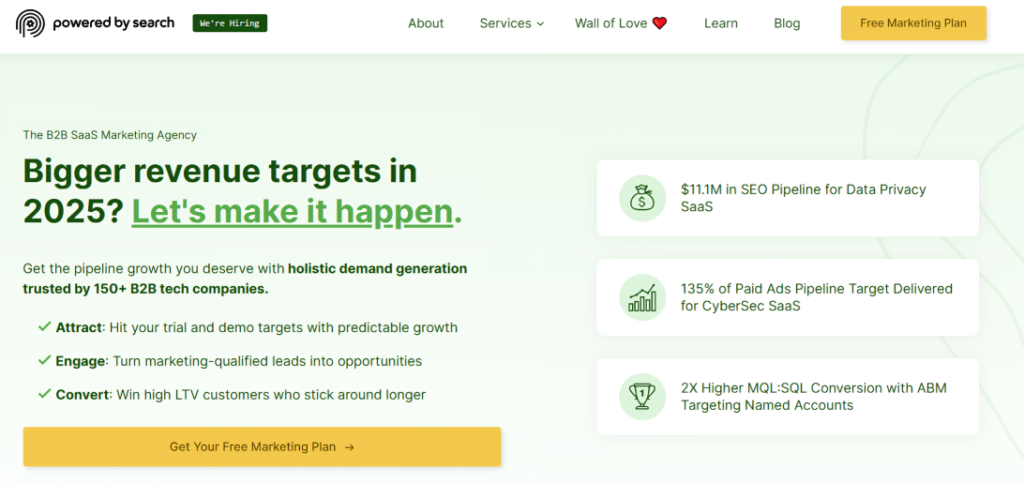This is a crucial component of managing a successful B2B SaaS business: making a marketing budget. A good budget helps marketing efforts to be aligned with the business goals, ensures the resources are assigned in a way that they can optimize the outcomes, and ultimately ensures going after the business outcomes that matter and tracking the results. We hope that this precise guide will take you step-by-step through what you have to be aware of to create a ground-breaking B2B SaaS advertising budget.
Table of Contents
The Importance of Getting the B2B SaaS Marketing Budget Right
A good marketing budget reflects the focus its organization needs to execute that strategy. A vague/undefined budget can result in the scattering of marketing efforts whereby resources are wasted, and opportunities missed. If, for example, a SaaS company fails to allocate adequate resources toward customer acquisition, it risks losing ground to more aggressive competitors. Conversely, spending money on poorly performing channels with no regard for returns can suck up resources better spent elsewhere. A properly structured budget helps strike that balance to ensure that marketing supports, and indeed accelerates business growth.
Start the Process: Research Your Market and Strategize
Market research is what sets the stage for an effective marketing budget. For starters, make sure you understand the audience you are targeting — what do they need, what are their pain points, and how do they make decisions? If your SaaS product targets mid-size enterprises in the healthcare industry, then include compliance-focused messaging and educational content that addresses industry-specific challenges in your strategy.
Also, you can do your competitive analysis to find market gaps. Are your businesses heavily investing in LinkedIn advertisements or sponsoring industry events? This can help you differentiate and prioritize your spending in the places where they are focused. Adding a market research phase and a strong plan means your budget is focused on achieving a set goal.
Define KPIs and Develop a Marketing Budget
Defining specific KPIs is a crucial part of the budget-planning process. They are necessary to be able to measure whether you are spending well (or not, for that matter). Some examples would be, if your goal is to increase MRR to 20%, the KPIs would include the volume of leads, conversion rates, average deal size, etc.

Once KPIs have been established, you can allocate a budget against those channels based on the expected delta for those metrics. If the paid search had been consistently delivering a significant number of good-quality leads at a low cost, it deserves a larger chunk of the budget. On the flip side, however, high-cost, low-converting channels may be retrenched or further explored at other tests before committing additional to it
Know Where You Are: Essential Marketing Metrics
Knowing your baseline metrics will help you set reasonable goals and expectations. In this regard, important metrics to focus on are customer acquisition cost (CAC), lifetime value (LTV), churn rate, and funnel conversion rates at different stages. So if your CAC is $1,000 and your LTV is $3,000, you have a 3:1 LTV-to-CAC ratio, and that is healthy accounting for the average SaaS.
With this knowledge/these numbers, you can model out different scenarios for your budget and understand the potential ROI of different initiatives. So, for example, if you want to increase your budget for content marketing by 20% next year, you should be able to extrapolate how that will translate into sessions, leads, and revenue.
Establish the Right Budget
Finding the right budget means understanding your growth ambitions, and balancing those against your financial realities. Higher marketing percentages, generally between 20% and 30%, aren’t unusual for early-stage SaaS companies. This indicates a necessity to rapidly build brand awareness and acquire a customer base.
For mature companies, the name of the game moves more to optimization and retention, and marketing budgets are usually in the 6% to 12% of revenues range. For example, a SaaS company with 10 million ARR typically spends about $1 million to $1.2 million on marketing, but it will target channels that have given it consistent ROI to do so.
Distributing Budget to Different Channels
When you figure out the overall budget, the next step is to allocate it to different channels. Each channel serves a different function in the customer journey from awareness to conversion.
Paid Advertising
Next up is paid advertising which can be useful in driving instant results, so it is a useful component to a lot of SaaS marketing strategies. Take Google Ads for instance, which works very effectively for high-intent search traffic. A SaaS business selling project management software might optimize for terms like “best project management tool for IT teams” to bring in prospects who are looking for a solution.
In contrast, if you are B2B SaaS and want to act for a company on a sectoral or role basis, LinkedIn Ads are the way to go. For instance, it is much simpler to connect directly with decision-makers in your target profession if your product is tailored for HR practitioners on LinkedIn.
Content Marketing
Most importantly, a short blog for a spokesperson guru is completely different from a long-substance one. Such examples are blog posts, whitepapers, case studies, webinars, etc. For instance, a cybersecurity SaaS company might produce a detailed guide on the best ways to secure remote workers, establishing itself as a thought leader in that area.
This is an integral part of content marketing, with a focus on SEO so that your content can rank high on search engine pages. The best methods are investing in tools such as Ahrefs, and SEMrush, and hiring SEO specialists.
Events and Webinars
A well-organized, perfectly executed event, or a compelling webinar, can do wonders for lead generation or for building your brand presence. For example, leading a webinar on “How to Automate Your Sales Process with the Right CRM” will draw in qualified leads who are already interested in your solution.
Additionally, sponsoring industry conferences or attending trade shows may increase its visibility and credibility. And although these initiatives represent a big investment upfront, the networking and lead generation potential can yield high ROI.
Public Relations
Trust, credibility, and visibility are built through PUBLIC RELATIONS (PR) in the market. A common approach to PR could be, for example, writing thought leadership pieces for industry journals, getting speaking slots at big events and working with influencers who have a presence in the market you’re targeting.
An example of this might be a SaaS company in the fintech space working with a PR agency to receive coverage in major financial publications which will build credibility in the eyes of potential customers and investors alike.
Sales & Marketing Technology (MarTech)
While they sound not so impressive, the mere fact of investing in a MarTech stack from the right vendors can increase the efficiency and effectiveness of your marketing activities significantly. Popular options are customer relationship management (CRM) systems such as HubSpot and Salesforce, marketing automation platforms such as Marketo, and analytics tools such as Google Analytics and Mixpanel.

Say you plan to leverage a marketing automation platform that nurtures leads with tailored email campaigns for higher conversion rates and a shorter sales cycle.
Personnel Costs
On internal teams, staff expenses account for a sizable portion of the budget. This includes pay, benefits, and training for marketing personnel. Your strategy will dictate whether or not you will need to hire freelance or agency talent specializing in SEO, content creation, paid media, etc.
Evaluate Results and Pivot
Tracking performance is key to making sure your marketing budget gets the biggest possible return on investment. Some examples of KPIs that can be tracked are CAC, ROMI (Return on marketing investment), lead to customer conversion rate, cost per lead (CPL), and customer lifetime value (CLV).
For instance, a campaign may produce many leads, but very few of them might convert; it could indicate that the campaign does not match the target audience. In this case, you may review the campaign itself or reallocate the budget to better-performing channels.
Conducting regular budget reviews—monthly, quarterly, and annually—keeps you agile and responsive to changing market conditions. You can maximize your results and optimize your spending by continuously analyzing performance and making data-driven changes.
2025 Marketing Budget Trends
When we think of the future of SaaS marketing, certain trends have become an inseparable part of the bigger picture with a long-term perspective. One prominent trend is the growing use of AI-powered tools for activities like content generation, customer segmentation, and predictive analytics. Personalization will become even more prevalent as companies use data to provide highly customized experiences at every touch point.
One such trend is the rising significance of video content and interactive media. With attention spans getting shorter day by day, riveting formats such as short videos, live demos, and interactive webinars that can capture and retain audience attention will become increasingly crucial.
(ABM) will maintain momentum, with businesses increasingly focusing on targeted initiatives for high-value clients. It relies on marketing and sales working closely together, and on advanced data analysis that can determine and score-key accounts.
Staffing Considerations
Your marketing team holds the key to executing your budget. Striking the right balance is key between in-house staff and working with outside partners. While in-house teams domain know product and closely align with company goals, agencies, and freelancers take advantage of expertise and flexibility.
For instance, a SaaS company with a small marketing team may decide to outsource its paid media management to an agency that specializes in that domain and has a proven record. It may do so while also investing and training its in-house content team to acquire better skills in SEO and copywriting.
What Sets Powered By Search Apart
Powered By Search has a different approach to B2B SaaS marketing than a traditional agency. They are specially trained in SaaS and tailor all their strategies around B2B companies so that every initiative leads to direct results in business.
Powered By Search is all about data-driven decision-making, leveraging advanced analytics to optimize campaigns and maximize ROI. Their team of specialists works hand in hand with clients to create tailor-made solutions for everything from scaling demand generation to increasing customer retention to entering fresh territories.

Conclusion
This article explores the various facets of creating a B2B SaaS marketing budget that drives meaningful results for your business. Define clear objectives, focus on high-ROI channels, and use resources wisely, and your marketing can lead to substantial growth.
Whether you’re a startup with plans for immediate growth or a more mature company prioritizing retention, a thoughtfully plotted marketing budget is your GPS for success. SaaS is a dynamic space, so constantly review and recalibrate your budget to maintain your competitive edge. marketing team is the backbone of your budget execution. Finding the right balance between in-house staff and external partners is crucial. In-house teams offer deep product knowledge and close alignment with company goals, while agencies and freelancers provide specialized expertise and flexibility.
For example, a SaaS company with a small marketing team might outsource its paid media management to an agency with a proven track record in that area. At the same time, it might invest in training its in-house content team to improve SEO and copywriting skills.


